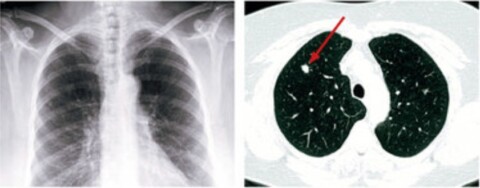The Low Down on the Low-dose CT Lung Cancer Screening

What is a low-dose CT lung screening?
The low-dose CT (LDCT) lung screening is a test with a low-dose CAT scan which can identify small nodules or other abnormalities in your lungs. It allows for early detection of lung cancer, before there are symptoms, which may make it easier to treat. Studies have shown that this screening can reduce the mortality of lung cancer for those who are at high risk and improve the risk of surviving five years or more by 60%. In addition, the LDCT might also show if you have other conditions or diseases that need to be treated.
You can think of this screening like other health screenings, such as mammograms, which are conducted annually to routinely assess lung health. The LDCT is a noninvasive test, in which the actual scanning is over within six seconds! The screening procedure is quite simple—you lie on a table that slides in and out of an CT scan machine while it takes multiple pictures of your lungs. A computer then compiles these images into a comprehensive image.
During the scan, you will be exposed to low levels of radiation. The level of radiation is more than an X-ray but much lower than a regular chest CAT scan. To put it into perspective, you will receive about the same amount of radiation from six months in your natural environment.
Who should get one?
Talk with your doctor about getting a low-dose CT lung cancer screening if you are:
- Between the ages of 55-77
- Current or former smoker—with a 20 pack per year or equivalent of smoking history.
Your doctor will:
- Go over benefits and harms of CT screenings, provide exam follow up, and discuss possible diagnosis with your ordering provider.
- Give education on the importance of adherence to annual screening and willingness to undergo diagnosis and treatment.
Insurance Coverage:
Medicare and many private health insurance plans cover lung cancer screening without cost-sharing, but eligibility criteria varies based on type of plan you have and many plans are currently updating their criteria to match new guidelines. Click here to learn more.
Improvements in Technology:
The image below shows two scans of the same patient. The image on the left is a traditional chest X-ray and shows many anatomical features—bones, tissues, lungs—but does not show any malignancies. The image on the right is a low-dose CT scan, which takes 1mm sliced images of the chest and is able to show the malignancy indicated under the red arrow. (Courtesy of Cleveland Clinic)

How do I get a low-dose lung cancer screening at Island Health?
If you think you meet the criteria above, meet with your primary care provider to discuss a referral for the LDCT scan. They can help answer any further questions and support you in accessing this state-of-the-art screening!
Published on August 15, 2023
